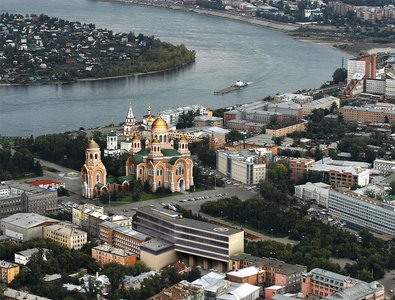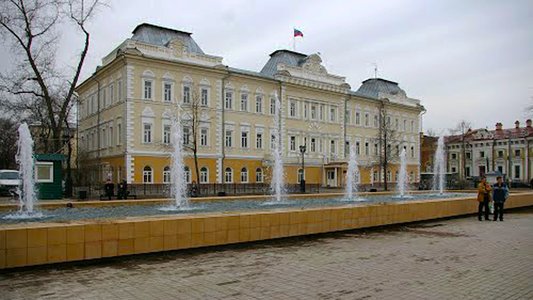Alexander Garden
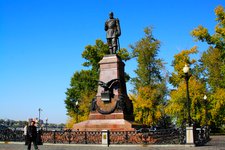
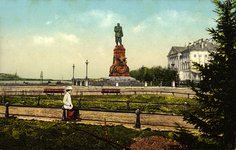

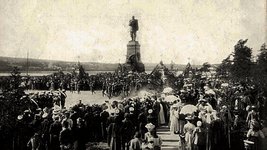
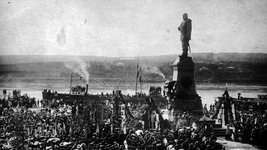
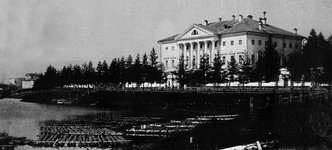
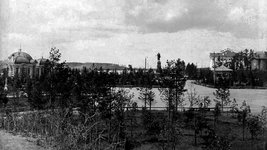
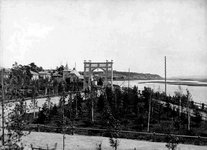
Alexander Square (also Alexander Garden) - a park in the city of Irkutsk. Located on the corner of the Great street (now K. Marx street) and the Angara embankment (now Gagarin Boulevard). Fundraising for the monument to Alexander III and the formation of an area under it had just begun, and members of the Monument Building Committee were already thinking about implementing a plan to create a park or park around it. In the spring of 1901, work began to fill the area. The original opening of the monument was planned in 1903.
In this regard, on January 17, 1903, Governor-General A.I. Panteleev turned to St. Petersburg's Dr. A.E. Pomological Garden, specializing in breeding and selection of garden crops of A.E. Regel who immediately agreed to help. By the end of June 1903 A.E. Regel completed the preparation of options for plans and a list of plants for the future square. But the construction of the monument was delayed, and the creation of the square was delayed. By the end of September 1904, 71 apple trees were planted; the larch alley was completed and 70 trees were planted there, for the rest of the distance 33 more trees were planted, and 33 more remained to be planted.
But in general, the construction of the monument and the square around it in 1904–1905 practically ceased due to the Russo-Japanese War and the ensuing revolution. By June 1905, only three rows of trees were planted and the fourth began. In addition, the embankment was being improved. Around the landings, a temporary wooden fence was created with a length of about 300 m to protect against cattle. All this was arranged at the expense of the Irkutsk Governor-General Count P.I. Kutaisova. At the expense of P.I. Kutaisova Boulevard was arranged in four rows of trees on the side of the square, which was adjacent to Naberezhnaya Street.
Planting trees in the future park did not continue until 1907, when work was completed in full swing to complete the installation of the monument. At the final stage of the erection of the monument, the issue of the layout of the square again became relevant. The project, developed in 1903, remained as the basis for the planning of green plantings.
The lattice around the monument, ordered in St. Petersburg, arrived in Irkutsk late, its installation and installation of the lighting lamps made there also dragged on until the spring of 1909. In May 1909, a decision was made to construct an external fence of the park. The contract for the construction of the grate and four gates to it with gates was taken over by Shelekhov and Korenev, the owners of a mechanical workshop on Troitskaya Street in Irkutsk. At the end of 1910 the fence was completed. Today, the transferred part of this fence was preserved near the building on the street. 5th Army, 2.
On the eve of the summer season, at a meeting of the City Duma on April 5, 1911, the chairman of the city commission for improving streets, squares and boulevards, the vowel of the Duma and the famous architect V.A. Rassushin (who also became the chairman of the commission for the construction of the public garden) presented and described in detail the outline sketch of the layout of the garden square at the monument. According to his project, it was planned to place playgrounds for games in the square. The proposal was approved by the Duma. By July 20, 1912, a buffet pavilion, a gazebo and other buildings were built.
The official opening of the square took place on July 30, 1912. Among the buildings located in the garden were: a kursal, a pavilion for a buffet, a pavilion for the sale of milk (these pavilions were called even large and small, respectively), a gazebo, a grotto made of stone that adjoined closely to the dairy pavilion. A fountain and a water supply system were arranged in the square, the water into which was originally supplied from the museum of the East Siberian Department of the Russian Geographical Society, and then from the water pumping station located on the corner of Kazarminskaya and Naberezhnaya. Interesting that V.A. Rassushin at his own expense, built an arch decorated with electric bulbs. The landscaping of the park ceased in 1914. It was called “Aleksandrovsky” and, as contemporaries noted, became a great place for walking and relaxing for the Irkutsk people. The square was fenced, and a fee was charged for entering it.
By a resolution of the Presidium of the Irkutsk City Council of November 3, 1920, among other renames, Alexander Square became the square of the Paris Commune. In Soviet times, the square continued to be used for its intended purpose, receiving numerous visitors. Entrance to it until 1959, as before, was charged. As before the revolution, a children's park worked on the territory of the garden with swings, a carousel, giant steps and other unpretentious attractions. In the late 1950s, the total garden area was 3.8 ha.
The master plan for the reconstruction of the city in the early 1960s provided for free access to the Angara River and the improvement of the embankment. The territory of the garden was part of the boulevard planned on the promenade. According to this document, the Irkutsk City Council of Workers' Deputies by a decision No. 300 of May 9, 1960 ordered the city department of culture and the director of the garden to surrender the territory of the square to the city department of public utilities by May 25. The decision stated that "in order to improve the services for the rest of workers, the territory and all the structures of the railway garden of the Irkutsk-I station should be transferred to the balance of the garden named after the Paris Commune." So, the former Alexander Garden was partially destroyed, many buildings were liquidated, and its staff was transferred to Glazkovo, the railway garden, which from that time began to be called the garden of the Paris Commune and ceased to belong to the Office of the East Siberian Railway.
In this regard, on January 17, 1903, Governor-General A.I. Panteleev turned to St. Petersburg's Dr. A.E. Pomological Garden, specializing in breeding and selection of garden crops of A.E. Regel who immediately agreed to help. By the end of June 1903 A.E. Regel completed the preparation of options for plans and a list of plants for the future square. But the construction of the monument was delayed, and the creation of the square was delayed. By the end of September 1904, 71 apple trees were planted; the larch alley was completed and 70 trees were planted there, for the rest of the distance 33 more trees were planted, and 33 more remained to be planted.
But in general, the construction of the monument and the square around it in 1904–1905 practically ceased due to the Russo-Japanese War and the ensuing revolution. By June 1905, only three rows of trees were planted and the fourth began. In addition, the embankment was being improved. Around the landings, a temporary wooden fence was created with a length of about 300 m to protect against cattle. All this was arranged at the expense of the Irkutsk Governor-General Count P.I. Kutaisova. At the expense of P.I. Kutaisova Boulevard was arranged in four rows of trees on the side of the square, which was adjacent to Naberezhnaya Street.
Planting trees in the future park did not continue until 1907, when work was completed in full swing to complete the installation of the monument. At the final stage of the erection of the monument, the issue of the layout of the square again became relevant. The project, developed in 1903, remained as the basis for the planning of green plantings.
The lattice around the monument, ordered in St. Petersburg, arrived in Irkutsk late, its installation and installation of the lighting lamps made there also dragged on until the spring of 1909. In May 1909, a decision was made to construct an external fence of the park. The contract for the construction of the grate and four gates to it with gates was taken over by Shelekhov and Korenev, the owners of a mechanical workshop on Troitskaya Street in Irkutsk. At the end of 1910 the fence was completed. Today, the transferred part of this fence was preserved near the building on the street. 5th Army, 2.
On the eve of the summer season, at a meeting of the City Duma on April 5, 1911, the chairman of the city commission for improving streets, squares and boulevards, the vowel of the Duma and the famous architect V.A. Rassushin (who also became the chairman of the commission for the construction of the public garden) presented and described in detail the outline sketch of the layout of the garden square at the monument. According to his project, it was planned to place playgrounds for games in the square. The proposal was approved by the Duma. By July 20, 1912, a buffet pavilion, a gazebo and other buildings were built.
The official opening of the square took place on July 30, 1912. Among the buildings located in the garden were: a kursal, a pavilion for a buffet, a pavilion for the sale of milk (these pavilions were called even large and small, respectively), a gazebo, a grotto made of stone that adjoined closely to the dairy pavilion. A fountain and a water supply system were arranged in the square, the water into which was originally supplied from the museum of the East Siberian Department of the Russian Geographical Society, and then from the water pumping station located on the corner of Kazarminskaya and Naberezhnaya. Interesting that V.A. Rassushin at his own expense, built an arch decorated with electric bulbs. The landscaping of the park ceased in 1914. It was called “Aleksandrovsky” and, as contemporaries noted, became a great place for walking and relaxing for the Irkutsk people. The square was fenced, and a fee was charged for entering it.
By a resolution of the Presidium of the Irkutsk City Council of November 3, 1920, among other renames, Alexander Square became the square of the Paris Commune. In Soviet times, the square continued to be used for its intended purpose, receiving numerous visitors. Entrance to it until 1959, as before, was charged. As before the revolution, a children's park worked on the territory of the garden with swings, a carousel, giant steps and other unpretentious attractions. In the late 1950s, the total garden area was 3.8 ha.
The master plan for the reconstruction of the city in the early 1960s provided for free access to the Angara River and the improvement of the embankment. The territory of the garden was part of the boulevard planned on the promenade. According to this document, the Irkutsk City Council of Workers' Deputies by a decision No. 300 of May 9, 1960 ordered the city department of culture and the director of the garden to surrender the territory of the square to the city department of public utilities by May 25. The decision stated that "in order to improve the services for the rest of workers, the territory and all the structures of the railway garden of the Irkutsk-I station should be transferred to the balance of the garden named after the Paris Commune." So, the former Alexander Garden was partially destroyed, many buildings were liquidated, and its staff was transferred to Glazkovo, the railway garden, which from that time began to be called the garden of the Paris Commune and ceased to belong to the Office of the East Siberian Railway.

